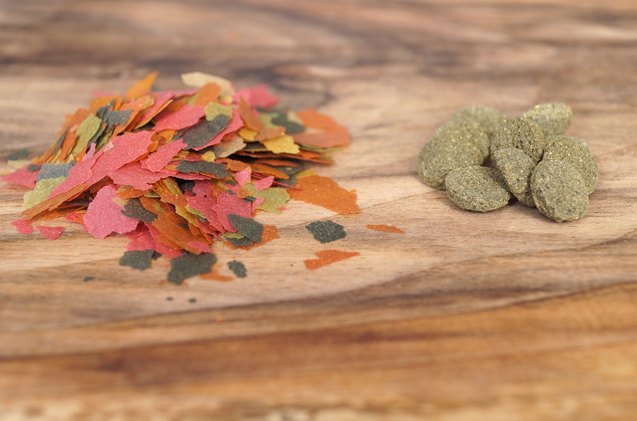What You Need to Know About Feeding Your Fish

When it comes to pets of any kind, one of the most controversial topics has to be diet. Everyone has an opinion on pet food, and fish are no different in this matter. Fish are not finicky eaters, in most cases. Whatever is offered they will learn to accept, but not all fish foods are created equally. Let’s talk about the types of fish foods available, and the pros and cons of each one.
Types of Fish Foods
Fish foods come in an extremely broad variety. The most common fish food for beginner aquarists is flake food. It’s widely available, inexpensive, and appears to do the job. Most domesticated fish will readily accept flake foods without much trouble. That being said, those who are more advanced in the hobby tend to steer clear of flake foods, regardless of the quality or ingredients. The first reason is that flake foods decompose quickly once saturated, which can cause water quality issues in return. Another reason to avoid flake food is that when fish come to the surface to eat it, they gulp in air, which can cause swim bladder issues, among other things.
Related: 4 Annoying Pests Found in Your Freshwater Aquarium
Foods that are in pellet form offer a longer span of time for the fish to eat them before it decomposes. Pellets sink in the water and eliminate the issue of fish gulping air. It also stops one dominant fish from eating more than the others, because it takes longer for them to eat. In the same family as pellets, some companies offer crumbles and sticks. These foods are the same as pellets in nature, just in different shapes. If you’re feeding pellets, be sure to get one in a size that is proportionate to the fish you are feeding.
Frozen fish foods are viewed highly by most hobbyists. It is about as close to feeding live as you can get, without keeping living worms and shrimp around your home. It comes in many varieties, including blood worm, black worm, brine shrimp, and daphnia. Frozen foods can be kept in the freezer for extended lengths of time without going bad, and are higher in nutrients than commercial foods. Each type comes proportioned for easy prep, and can be fed by simply popping it out of the container and into the aquarium.
The last type of fish food is live. Live foods are nutritionally the best, and obviously the closest to the natural diets of fish. Some of these you can culture yourself, such as small white worms and daphnia. These are safe and easy to feed, but many people are squeamish about keeping them, and others don’t want to be bothered with feeding the fish food. There are some dangers with live foods, such as mosquito larvae – if the larvae hatch, there is risk of mosquito-borne illnesses, so use caution if you choose this route.
Quality of Fish Food
Now that we’ve discussed the many types of fish foods, what about what it is made out of? There are so many types of fish food on the market, made out of just about everything imaginable. The important thing to look for in the ingredients is that there are not a lot of fillers. It’s the same idea as what you would look for in dog or cat food – what is the first ingredient? That is, what is there the most of in the food you’re looking to buy? Typically, you want to look for specific ingredients, and not something that says “fish parts.” The fish food that can be bought at department stores typically is not nutritional for the fish. The fish food offered at an aquarium store is likely better in quality. There are also sources online for many fish foods. My personal favorite is kensfish.com.
Related: Growing and Controlling Algae in Your Aquarium
How Much & How Often?
How often you feed your fish depends on a few factors. If the fish are young fry or juveniles, they will need to eat more often. Fry should be fed several times per day, while juveniles should be fed once or twice a day to promote growth and health. Once a fish reaches adulthood, they can be fed once a day. Many hobbyists would recommend only feeding once every two or three days, as this is closer to how a fish would live in its natural habitat. Much of the question of how often depends also on the fish in question. Fish like plecos need a constant source of driftwood for digestion, and will graze around for algae around the clock. Goldfish also eat constantly in the wild, but keep in mind that what goes in must come out, and can affect the quality of your water. The other consideration is if you are conditioning fish to spawn, well fed fish tend to be more willing to breed.
When feeding your fish, the question of how much depends on your tank. You should only feed what your fish can consume in a 10 minute period. If there is leftover food hanging around long after feeding, then cut back.
There are many choices for what to feed your fish, and the best method of choosing is research the species of fish, find out what they eat in the wild, and find a food that closely resembles it in ingredients. Feed your fish enough to be healthy, but overfeeding can cause health issues, and even obesity. Be informed, know your fish, and they will live a long, well-fed life.
Summer Davis is the mom of three kids, four dogs, and several tanks of fish. She boasts a passion for all animals, whether they are in the water or on land. This fish aficionado has kept many different species in her time, but holds a special place in her heart for wild and domestic bettas. When she’s not talking about fish, Summer “spins” her extra time as the director of a baton twirling organization.

Summer Davis is the mom of three kids, four dogs, and several tanks of fish. She boasts a passion for all animals, whether they are in the water or on land. This fish aficionado has kept many different species in her time, but holds a special place in her heart for wild and domestic bettas. When she's not talking about fish, Summer "spins" her extra time as the director of a baton twirling organization."
More by Summer Davis
























